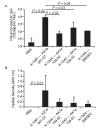Nanoemulsion W805EC improves immune responses upon intranasal delivery of an inactivated pandemic H1N1 influenza vaccine
- PMID: 22989689
- PMCID: PMC3488283
- DOI: 10.1016/j.vaccine.2012.09.007
Nanoemulsion W805EC improves immune responses upon intranasal delivery of an inactivated pandemic H1N1 influenza vaccine
Abstract
Currently available influenza vaccines provide suboptimal protection. In order to improve the quality of protective immune responses elicited following vaccination, we developed an oil-in-water nanoemulsion (NE)-based adjuvant for an intranasally-delivered inactivated influenza vaccine. Using a prime-boost vaccination regimen, we show that intranasal vaccines containing the W(80)5EC NE elicited higher titers of serum hemagglutination inhibiting (HAI) antibody and influenza-specific IgG and IgA titers compared to vaccines that did not contain the NE. Similarly, vaccines containing the W(80)5EC NE resulted in higher influenza-specific IgA levels in the bronchoalveolar lavage (BAL) fluid and nasal wash when compared to vaccines formulated without NE. The higher antibody titers in mice immunized with the NE-containing vaccines correlated with reduced viral loads in the lungs and nasal turbinates following a high dose viral challenge. Mice immunized with vaccines containing the W(80)5EC NE also showed a reduction in body weight loss following challenge compared to mice immunized with equivalent vaccines produced without NE. Taken together, our results show that the W(80)5EC NE substantially improves the magnitude of protective influenza-specific antibody responses and is a promising mucosal adjuvant for influenza vaccines and vaccines against other mucosal pathogens.
Published by Elsevier Ltd.
Figures






Similar articles
-
Bacterium-like particles supplemented with inactivated influenza antigen induce cross-protective influenza-specific antibody responses through intranasal administration.Vaccine. 2012 Jul 6;30(32):4884-91. doi: 10.1016/j.vaccine.2012.04.032. Epub 2012 Apr 23. Vaccine. 2012. PMID: 22537989
-
Efficacy, immunogenicity and stability of a novel intranasal nanoemulsion-adjuvanted influenza vaccine in a murine model.Hum Vaccin. 2010 Jul;6(7):585-94. doi: 10.4161/hv.6.7.11818. Hum Vaccin. 2010. PMID: 20421727
-
Alkyl polyglycoside, a highly promising adjuvant in intranasal split influenza vaccines.Hum Vaccin Immunother. 2017 Jun 3;13(6):1-9. doi: 10.1080/21645515.2016.1278098. Epub 2017 Jan 27. Hum Vaccin Immunother. 2017. PMID: 28129034 Free PMC article.
-
Intranasal Inactivated Influenza Vaccines: a Reasonable Approach to Improve the Efficacy of Influenza Vaccine?Jpn J Infect Dis. 2016;69(3):165-79. doi: 10.7883/yoken.JJID.2015.560. Jpn J Infect Dis. 2016. PMID: 27212584 Review.
-
Studies on the usefulness of intranasal inactivated influenza vaccines.Vaccine. 2010 Aug 31;28(38):6393-7. doi: 10.1016/j.vaccine.2010.05.019. Epub 2010 May 20. Vaccine. 2010. PMID: 20493820 Review.
Cited by
-
Injectable Excipients as Novel Influenza Vaccine Adjuvants.Front Microbiol. 2019 Jan 24;10:19. doi: 10.3389/fmicb.2019.00019. eCollection 2019. Front Microbiol. 2019. PMID: 30733711 Free PMC article.
-
Nanoemulsions Based Therapeutic Strategies: Enhancing Targeted Drug Delivery against Breast Cancer Cells.Int J Nanomedicine. 2025 May 14;20:6133-6162. doi: 10.2147/IJN.S488545. eCollection 2025. Int J Nanomedicine. 2025. PMID: 40385492 Free PMC article. Review.
-
Silicone Oil-Based Nanoadjuvants as Candidates for a New Formulation of Intranasal Vaccines.Vaccines (Basel). 2021 Mar 8;9(3):234. doi: 10.3390/vaccines9030234. Vaccines (Basel). 2021. PMID: 33800507 Free PMC article.
-
Induction of systemic and mucosal immunity against methicillin-resistant Staphylococcus aureus infection by a novel nanoemulsion adjuvant vaccine.Int J Nanomedicine. 2015 Dec 3;10:7275-90. doi: 10.2147/IJN.S91529. eCollection 2015. Int J Nanomedicine. 2015. PMID: 26664118 Free PMC article.
-
Comparative genomics of QX-like infectious bronchitis viruses in Korea.Arch Virol. 2017 May;162(5):1237-1250. doi: 10.1007/s00705-016-3208-x. Epub 2017 Jan 23. Arch Virol. 2017. PMID: 28116527 Free PMC article.
References
-
- Glezen WP. Cold-adapted, live attenuated influenza vaccine. Expert Rev Vaccines. 2004;3(2):131–9. - PubMed
-
- Riddiough MA, Sisk JE, Bell JC. Influenza vaccination. JAMA. 1983;249(23):3189–95. - PubMed
-
- Ghendon Y. The immune response of humans to live and inactivated influenza vaccines. Adv Exp Med Biol. 1989;257:37–45. - PubMed
Publication types
MeSH terms
Substances
Grants and funding
LinkOut - more resources
Full Text Sources
Medical
Miscellaneous

